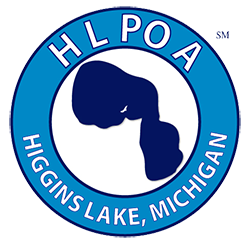

June Board Meeting Minutes, w/Qtrly Financials Now Posted
Resolution: Summer Lake Level — Click here for details.
Summer Lake Level Resolution:
The following resolution regarding the County’s management of the Cut River Dam and the Legal (Summer) Lake Level was approved by the HLPOA Board on October 15, 2018 and presented to the County Board of Commissioners. The Higgins Lake Land Conservancy (HLLC) authored/presented an identical resolution. The resolution requests the County adopt the 2010 Spicer Group recommendations for modifying and managing the Cut River Dam to better maintain the legal lake level throughout the summer months.
May Board Meeting Minutes Now Posted.
2019 Annual Meeting Date Set — New Location. Click here for details
2019 Annual Meeting Details:
The 2019 HLPOA Annual Meeting of the Members is scheduled to be held in the Grade School (not the High School as in the recent past, due to construction). The date is Saturday, July 13, 2019. The doors open at 8:00AM for refreshments and the meeting will start promptly at 8:45AM. It is scheduled to end at approx noon.
PLEASE NOTE: To repeat, the 2019 Annual Meeting will NOT be held at the High School due to planned construction/maintenance. This year it will be held in the Grade School gymnasium. The Grade School address is:
174 W Sunset Drive (aka, County Rd 100)
Senate Bill #1136 – Establishes Grant Request Process for AIS
Public Act 671 — Aquatic Invasive Species (AIS)
Senate Bill #1136 became part of Public Act (PA) 671 in December of 2018. This bill created a grant request process for funding the eradication of, and/or preventing the spread of, Aquatic Invasive Species (AIS) in Michigan inland lakes. This bill also requires the DEQ to establish an inland lake AIS control and eradication program. Bill #1136 was signed by the Governor and filed with the Secretary of State on December 31, 2018 and becomes effective March 29, 2019. A copy of Bill #1136 is attached, below:
New 2019 State Boating Law for Preventing the Spread of AIS – Click Here.
New 2019 State Boating Law — Aimed at Preventing the Spread of Aquatic Invasive Species (AIS):
New Requirements for Michigan Boaters and Anglers to Prevent the Introduction and Spread of Aquatic Invasive Species
Michigan’s Natural Resources and Environmental Protection Act (Act 451 of 1994) Part 413 has recently been amended with changes for boaters and anglers that take effect March 21st, 2019.
The changes are intended to strengthen protection for Michigan waterways against the introduction and spread of aquatic invasive species.
Prior to the amended changes, the law only required that a person not place watercraft or trailers in the waters of Michigan if an aquatic plant is attached. In addition to this requirement, the new changes require all of the following prior to transporting any watercraft over land:
- Removing all drain plugs from bilges, ballast tanks, and live wells
- Draining all water from any live wells and bilges
- Ensuring that the watercraft, trailer, and any conveyance used to transport the watercraft or trailer are free of aquatic organisms, including plants
This means that after trailering boats, and before getting on the road, boaters must pull plugs, drain water, and remove plants and other debris. Additionally, the new amended law also incorporates requirements from Michigan’s Department of Natural Resources’ Fisheries Order 245 that will also help to prevent the introduction and spread of aquatic invasive species as well as fish diseases:
- A person shall not release bait fish in any waters of this state. A person who collects fish shall not use the fish as bait or cut bait except in the inland lake, stream, or Great Lake where the fish was caught, or in a connecting waterway of the inland lake, stream, or Great Lake where the fish was caught if the fish could freely move between the original location of capture and the location of release.
- A person, who catches fish other than bait fish in a lake, stream, Great Lake, or connecting waterway shall only release the fish in the lake, stream, or Great Lake where the fish was caught, or in a connecting waterway of the lake, stream, or Great Lake where the fish was caught if the fish could freely move between the original location of capture and the location of release.
Violation of the law is a state civil infraction and violators may be subject to fines up to $100.
To comply with the law and prevent the introduction and spread of aquatic invasive species, boaters should:
- CLEAN boats, trailers and equipment.
- DRAIN live wells, bilges and all water.
- DRY boats and equipment.
- DISPOSE of unwanted bait in the trash.
Please click on the link, below, to see the DEQ’s 2-sided card introducing this new state law and what it means to you:
Higgins Lake History and Formation Since Ice Age added under “Member News & Info” tab. Click Here.
Higgins Lake has a long a storied history, having originated after the last ice age left the state many thousands of years ago. Attached, below, are several documents you may click on to help in expanding your knowledge of our beautiful lake. The first of these documents is a brief history of the lake as prepared by Board member Bruce Carlton:
A Brief History of Higgins Lake
Below are two additional documents that provide more of a science-based introduction on the formation of Higgins Lake. The first is a recent article on “Glacial Lake Roscommon” that appeared in the July 5, 2018 issue of the Houghton Lake Resorter newspaper. This article discusses recently discovered evidence that the area including Higgins Lake, shortly after the last Ice Age ended, was once part of a much larger and deeper lake that may have covered an area greater than the entire Roscommon County. Following this is a 1921 Report published by the State of Michigan Geological and Biological Survey. The discussion of Higgins Lake begins on page 18 of this report and it describes the geological formation of lake, providing factual information on the lake’s level over the thousands of years after the Ice Age ended. At one point in time, many thousands of years ago, the lake level stabilized at 16 feet above today’s level. As the ground continued to rebound without the weight of a mile or more thickness of ice covering it, the lake level stabilized again at about 8 feet above today’s level, and later on it stabilized at 2 feet above today’s level.
Starry Stonewort (SSW) Update – November, 2018. Click here for details.
As many are aware, it was recently determined that Starry Stonewort, a potentially dangerous new invasive species, was present in Higgins Lake. In our fall newsletter we provided an explanation of what this invasive plant is, where it was found and what we were asking the DNR / DEQ to do to help control its spread. Many of our members took an active part in contacting various people to advise them of our situation and ask them to assist our lake. On November 20th a very important meeting was held with the DNR in which they unveiled their plan to deal with this threat. The HLPOA was encouraged that, to their credit, the DNR is intending to take steps to eliminate the Starry Stonewort cultures in their park launch areas and monitor and assess their success in doing so. The locations of concern that the DNR will be addressing are the navigational channels at the South Park, the North Park, the West Launch and the South Park Lagoon.
The following is the DNR Parks and Recreation Div (PRD) work plan for 2019:
- January: DNR/PRD will request a DEQ permit to dredge the entire South Higgins lagoon for navigational purposes.
- February: DNR/PRD will request an AIS mechanical harvest permit from the DEQ.
- Pending DEQ permit approval, the DNR and a select contractor will dredge, as appropriate, the three boating access sites prior to Memorial Day weekend.
- June: An AIS survey at the three boating access sites will be conducted. Pending the results, a treatment plan for the management of the AIS will be developed. Any necessary DEQ permits will be requested.
- July: Best management practices for AIS control will be initiated. This may include a multi-faceted approach involving algaecide/herbicide treatment followed by physical removal as needed.
- August: A post-treatment AIS survey will be conducted.
- September: Continuation of AIS control efforts will occur based on findings and best management practices.
The proposed dredging will be done in order to remove the plant and sediment from the locations where the dredging will take place. In addition, the DNR intends to continue sharing information with the HLPOA about efforts being made by the DNR at the boating access sites.
This is an important first step. The elimination of Starry Stonewort at the introduction sites still leaves us with other areas of the lake to control. We are working with the Higgins Lake Foundation to determine how best to harvest the plant, potentially with the DASH boat that they operate on Higgins Lake for just this purpose. Other systems available to control this plant are also being considered.
2018 Swimmers Itch Final Reports — Click here to view.
The following three items provide a summary of the 2018 Swimmer’s Itch program and the progress being made on this issue.
HLPOA OFFICE HAS MOVED!
The HLPOA office’s new location, effective January 1st, 2019 is:
211 N. Main St.
Roscommon, MI 48653
(in the Au Sable River Center)
This is a new physical location only for our office. Our mailing address (P.O. Box 55, Roscommon 48653), phone/fax numbers (ph.: 989-275-9181, fax: 989-275-9182), email address (hlpoa0@gmail.com) and website (www.hlpoa.org) all remain unchanged. The move benefits our members by reducing our monthly rent and utility costs.
